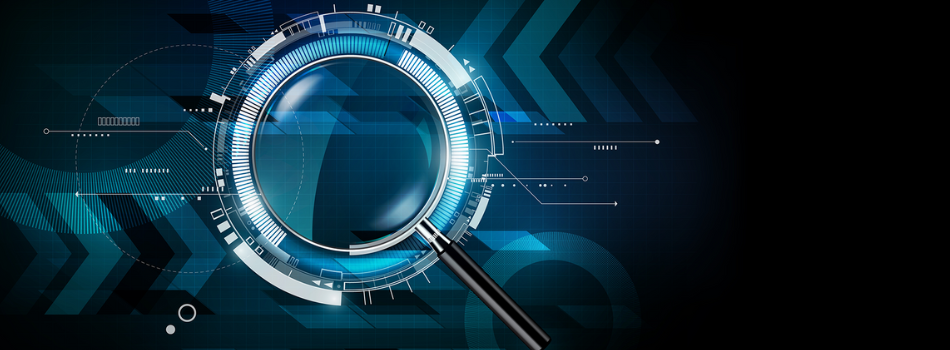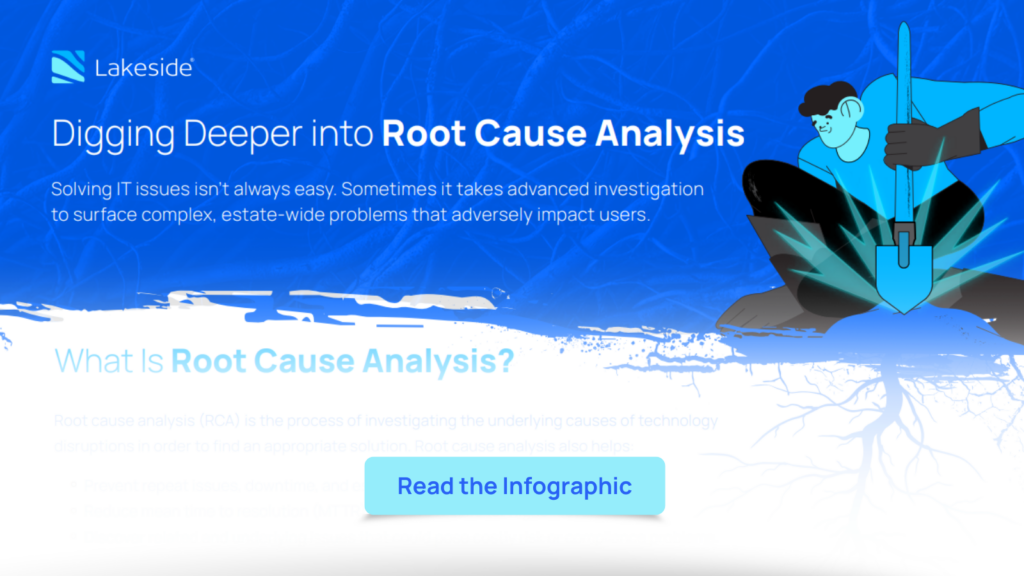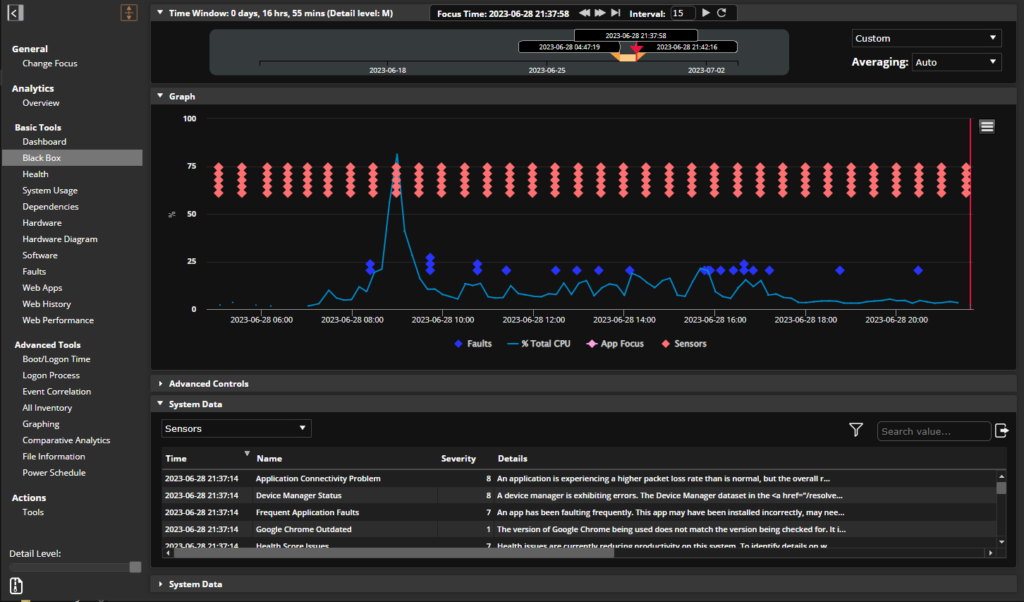Tools for RCA Success: How to Move IT Forward with Modern Root Cause Analysis

Explore the differences between traditional and modern root cause analysis, and how to use automated RCA for greater IT efficiency
This is the first in a three-part series exploring ways IT can upgrade its root cause analysis strategy, and criteria for evaluating and deriving the most value out of RCA tools. Learn more by reading the second part and third part, or by visiting Lakeside’s root cause analysis page.
IT environments are becoming increasingly complex. With dispersed workforces and the move to cloud infrastructure, organizations can no longer rely on traditional root cause analysis (RCA) software to diagnose and remediate IT issues.
It’s time for IT to revamp the approach to root investigation, too.
Finding the Root of IT Issues is a Top Priority
RCA is a method to identify the source of technology-related problems and resolve them, rather than just treating the symptoms. Accelerated troubleshooting can help save technicians’ time for higher-level tasks and improve users’ digital experience and productivity. That makes fast and efficient root cause analysis a significant concern for IT professionals.
According to Lakeside Software’s research on digital employee experience (DEX), reduced mean time to resolve (MTTR) — the average time taken to resolve an incident — is the top metric IT personnel incorporate into their goals. This metric helps to assess the efficiency of IT departments and support desk costs. With prompt remediation, users can go back to their activities, and IT resources can be directed to other activities.
That’s why RCA comes in handy. Effective diagnostics enable not only quick resolution but also the prevention of repeat incidents. Benefits include:
- Reduced downtime, leading to improved digital experience and engagement.
- Fewer help desk tickets, resulting in reduced IT costs.
- Increased productivity, thanks to improved end-user experience.
E-BOOK
Deeper RCA for Modern Digital Workplaces
What Is a Traditional RCA Approach?
More traditional approaches to root cause analysis focus on single-point causation. For example, solutions that show an individual issue and its cause rather than taking a contextual view of all conditions and previous events that may influence the incident.
This model is flawed because it lacks holistic visibility into the entire IT estate, which is becoming more sophisticated due to trends in cloud computing and the sheer amount of devices connected to corporate networks. In addition, the rise of remote and hybrid forms of work — with dispersed digital workplaces across different geographic locations — creates another layer of IT complexity for organizations to manage.
RCA that is focused on single-point causation might suggest remediations that address the issue at hand, but they miss an opportunity to understand the broader implications and ramifications of the incident.
In order to enhance digital employee experience and build IT operations that are better prepared for the future of digital workplaces, organizations should implement a more modern approach to root cause investigation. An intelligent RCA solution can resolve problems more quickly and effectively. In addition, it can also discover related and underlying problems that could end up posing future compliance risks or cybersecurity threats.
What Is a Modern RCA Strategy?
A more advanced and modern approach to root cause analysis goes beyond reactive support desk operations to take a more proactive role in incident remediation. Modern RCA is comprehensive enough to see across the entire scope of digital employee experience, including:
- Endpoint devices
- Users
- Networks
- Applications
- Software as a service (SaaS)
- Multi-cloud infrastructure
Modern root cause analysis is grounded in deep telemetry, in addition to machine learning (ML) and artificial intelligence (AI) capabilities. That’s how it’s able to provide full contextual insights into incident causation and remediation.
SOLUTION BRIEF
Root Cause Analysis for More Productive IT
How to Modernize Your Root Cause Analysis Strategy
Organizations can modernize incident remediation by deploying automated root cause analysis. These solutions leverage deep data, artificial intelligence capabilities, and automation to troubleshoot faster than a manual approach, and can even provide actionable insights and auto-fixes for lower-level service desk staff to quickly resolve a variety of issues.
In Lakeside’s The Future of Digital Workplaces report, 66% of surveyed employees indicated that time to resolve IT issues has a negative impact on their jobs, hindering their ability to meet customer needs, deliver tasks, and reach their targets. Those insights highlight the importance of prompt troubleshooting to better business outcomes.
AI Solutions on the Rise
Intelligent RCA solutions are shaping the future of incident diagnostics and remediation because they can:
- Identify causation based on prior events by using historical data to recreate the circumstances leading to an issue.
- Understand the context, correlate events, and offer fixes.
No wonder companies are revamping their spending on AI software. According to IDC, worldwide revenue for the IT market is expected to grow 19.6% year-over-year (YoY) in 2022 to $432.8 billion. IDC notes that this type of technology has become a differentiator for companies undertaking digital transformation strategies, enabling scalability, more efficient business processes, and improved decision-making.
AI-driven, contextual RCA can also help to increase an organization’s cybersecurity posture. For example, by having automated root cause analysis software with access to real-time and historical data, it’s possible to understand the context and identify if a device starts to behave in a way that has no historical precedence. This type of diagnostics could help to prevent the spread of malware and stop attacks before they escalate.
Key Components of Automated Root Cause Analysis Software
The main components of automated RCA that supports the needs of complex IT estates include:
- Comprehensive visibility across the entire IT estate, from endpoint devices to SaaS and cloud environments.
- Powerful analytics that draws on both real-time and historical data for a contextual understanding of the root cause.
- Issue prioritization to help technicians focus their efforts on widespread and high-impact problems.
- AI-driven automation to analyze data, make correlations between events, draw insights, and drive action.
Make the Shift to Automated RCA Software
Discover how a modern root cause analysis strategy can help your organization. Request a customized demo today.
Subscribe to the Lakeside Newsletter
Receive platform tips, release updates, news and more




